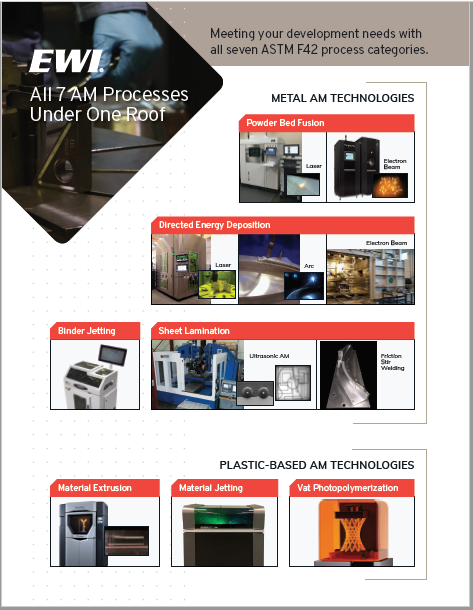
Additive Manufacturing Processes: The Seven Processes of AM
The Seven Processes of Additive Manufacturing
Additive manufacturing is the process of applying 3D-printing to industrial production that allows materials to be created without joints and with minimal post-processing. Multiple materials can be used during this process, which makes it easy to create new products with minimal waste and lower materials costs.

There are seven additive manufacturing production techniques. Each vary due to materials, layering, and machine technology needed. EWI specializes in all seven, and can help your team identify, design and implement the process that’s right for your application.
- Powder Bed Fusion
- Directed Energy Deposition
- Binder Jetting
- Sheet Lamination
- Material Extrusion
- Material Jetting
- Vat Photopolymerization
Powder Bed Fusion
This type of additive manufacturing uses either a laser or electron beam to melt and fuse material powder together to develop products. Here are the differences between the two types of powder bed fusion :
- Laser Powder Bed Fusion – In laser powder bed fusion, a laser is used to heat material in a powder form into 3D products. After a layer of powder has been indexed down, a new layer of powder is spread to continue the process. Ultimately, laser powder bed fusion does not require support.
- Electron Beam Powder Bed Fusion – This type of powder bed fusion is used to melt particles together in specific areas. The beam can be manipulated very fast, which speeds the overall process by allowing multiple melt pools to occur simultaneously.
Directed Energy Deposition
In directed energy deposition (DED), powder or metal wire is used with an energy source to add material or fuse a material onto an existing part or to create a new part. The process is generally used in large-scale additive manufacturing. Here are the three types of directed energy deposition:
- Laser DED – Laser DED deposits powder onto the build while being melted by the laser at the same time. This process can generate much faster build rates over conventional laser powder bed fusion.
- Arc DED (also known as wire arc additive manufacturing or WAAM) – An EWI specialty that is more dynamic than other additive manufacturing processes. Arc DED is suitable for large builds. An advantage for manufacturers is that existing arc-welding robots and power supplies.
- Electron Beam DED – EB-DED enables the manufacturing of large parts extremely fast, which gives it an advantage over other types of additive manufacturing. The process is applied in industries such as heavy machinery, construction, mining, and aerospace to make large, low-volume parts.
Binder Jetting
Metal binder jetting additive manufacturing uses an ink-jet print head to print a binder onto the powder which “binds” the metal particles together into a green state. The parts are then removed from the powder bed and must go through a debinding and sintering process (in an oven) to make the parts fully dense and hard. Parts typically shrink 20-25% during the sintering process.
Sheet Lamination
This type of additive manufacturing binds sheets of material to form a part. There are two types of sheet lamination additive manufacturing:
- Ultrasonic Additive Manufacturing – This type of sheet lamination uses ultrasonic vibrations to weld metal tapes together until it is able to form objects.
- Friction Stir Welding – Using friction stir welding enhances material properties as each layer is stirred. This creates diffusion and reduces the grain size for a secure bond.
Material Extrusion
In material extrusion, a filament or thermoplastic material is used to create parts. With this process, the filament (or thermoplastic) is heated and then continuously layered through a nozzle to create the final product or part. New materials are available that have metal filler inside the plastic “rods” that are extruded. The parts then go through the debinding and sintering step like binder jetting to make metal parts.
Material Jetting
New materials are available that have metal filler inside the plastic “rods” that are extruded. The parts then go through the debinding and sintering step like binder jetting to make metal parts.
Vat Photopolymerization
Unlike the other types of additive manufacturing, vat photopolymerization uses liquid resin. This photopolymer resin is applied layer by layer and then a UV light hardens the resin to create the final part or object.
Additive Manufacturing Tooling & Process Services
Searching for Additive Manufacturing Services? The team of experts at EWI is ready to help with any of the seven processes of additive manufacturing. We’re here to identify the best options to solve your challenge, develop the right engineering solution, and implement the new technology or processes. Give our team a call today at 614.688.5152 or submit a contact request.